Programs
Morris County
Conservation District
Council Grove, KS
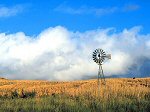
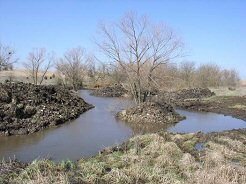
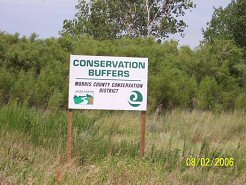
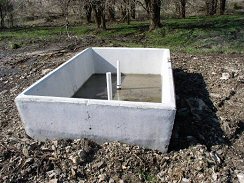
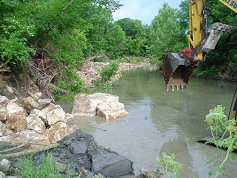
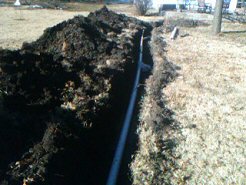
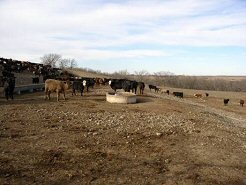
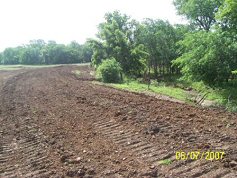
State Programs
WATER RESOURCES PROGRAM
The Morris County Conservation District provides a State cost-share program that helps protect and improve the Natural Resources. This is an investment that will generate economic and aesthetic returns. This generation and generations yet to come will reap dividends from a modest investment in management of the Natural Resources of Morris County. All structures cost-shared by the State are to be built to the USDA Natural Resources Conservation Service (NRCS) Field Office Technical Guide Standards and Specifications (eFOTG). NRCS provides technical assistance in design, layout and certification of conservation practices.
The District cost-shares 70% on Best Management Practices (BMP’s itemized below with a $3,500.00 limit per landowner). Sign-ups are ranked according to practice, high-priority area, erosion index, and soil saved.
Below are the components that the Conservation District is presently cost-sharing on:
Lined Waterways or Outlet
A waterway or outlet having an erosion-resistant lining of concrete, stone, synthetic turf reinforcement fabric, or other permanent material.
Grade Stabilization Structure
A structure to control the grade and head cutting in natural or artificial channels.
Critical Area Planting
Establishing permanent vegetation such as grasses or legume/forbs used as a part of a seed mixture on sites that have or are expected to have high erosion rates, and on sites that have physical, chemical or biological conditions that prevent the establishment of vegetation with normal practices.
Diversion
A channel constructed across the slope with a supporting ridge on the lower side.
Dry Hydrant
A non-pressurized permanent pipe assembly system installed into water source that permits the withdrawal of water by suction.
Fencing
Enclosing or dividing an area of land with a suitable permanent structure that acts as a barrier to livestock (does not include temporary fences).
Grassed Waterway
A constructed waterway or outlet shaped or graded and established in vegetation (grass or crop), as needed, for the safe disposal of runoff from a field, diversion, terrace, or other structure.
Pipeline
Pipeline installed for conveying water from a source of supply to points of use for livestock.
Pond
A water impoundment made by constructing a dam, embankment, or by excavating a pit or dugout.
Range Planting
Establishment of adapted perennial vegetation such as grasses, forbs, and legumes.
Spring Development
Improving springs and seeps by excavating, cleaning and providing collection and storage facilities.
Terrace
An earth embankment or a combination ridge and channel constructed across the slope on cropland only, except when used in conjunction with a confined animal feed operation.
Terrace Restoration
Restoring a terrace. A terrace is an earth embankment or a combination ridge and channel constructed across the slope on cropland only.
Watering Facility
A trough, tank, or waterer with needed devices installed to provide drinking water for livestock.
NON-POINT SOURCE PROGRAM
The NPS program offers cost-share on practices that will improve or maintain high water quality in Morris County. With this program the Conservation District cost-shares 70% on Best Management Practices (BMP’s itemized below with a $10,000.00 limit per landowner). Sign-ups are ranked according to practice, high-priority area, erosion index, and soil saved.
Below are the components that the Conservation District is presently cost-sharing on:
Access Road
An earthen roadway constructed by ground clearing and shaping for access to a relocated livestock facility.
Critical Area Planting
Establishing permanent vegetation such as grasses or legume/forbs used as a part of a seed mixture on sites that have or are expected to have high erosion rates, and on sites that have physical, chemical or biological conditions that prevent the establishment of vegetation with normal practices.
Diversion
A channel constructed across the slope with a supporting ridge on the lower side.
Fencing
Enclosing or dividing an area of land with a suitable permanent structure that acts as a barrier to livestock (does not include temporary fences).
Filter Strip
A strip or area of vegetation for removing sediment, organic matter, and other pollutants from runoff and waste water.
Grade Stabilization Structure
A structure to control the grade and head cutting in natural or artificial channels.
Grassed Waterway
A constructed waterway or outlet shaped or graded and established in vegetation (grass or crop), as needed, for the safe disposal of runoff from a field, diversion, terrace, or other structure.
Heavy Use Area Protection
The stabilization of areas frequently and intensively used by people, animals, or vehicles by establishing vegetative cover, by surfacing with suitable materials, and/or by installing needed structures.
Lined Waterways or Outlet
A waterway or outlet having an erosion-resistant lining of concrete, stone, synthetic turf reinforcement fabric, or other permanent material.
Land Smoothing
Removing irregularities on the land surface by use of special equipment.
Livestock Waste System
A planned system to manage liquid and solid wastes from a confined animal feeding operation (CAFO), including runoff from concentrated waste areas, with ultimate disposal in a manner which does not degrade air, soil or water resources.
Mulching
Applying weed/moisture barrier fabric to the soil surface.
Nutrient Management
Managing the amount, form, placement, and timing of application of plant nutrients.
On-site Wastewater System
A system composed of a septic tank/treatment field, a wastewater lagoon, or an alternative treatment system to treat wastewater from a single family residence, church, school, business or government office on the site at which it is generated. A domestic wastewater system installed in conformance with state regulations and county sanitary/environmental codes to prevent surface and groundwater contamination by disease-causing organisms, organic matter and chemicals.
Pasture and Hayland Planting
Establishing and re-establishing long-term stands of adapted species of perennial or reseeding forage plants. (Includes pasture and hayland renovation.)
Pipeline
Pipeline installed for conveying water from a source of supply to points of use for livestock.
Pond
A water impoundment made by constructing a dam, embankment, or by excavating a pit or dugout.
Pond Sealing or Lining
Installing a fixed lining of impervious material or treating the soil in a pond mechanically or chemically to impede or prevent excessive water loss.
Precision Land Forming
Reshaping the surface of land to planned grades.
Pumping Plant For Water Supply
A pumping facility installed to transfer water as part of an alternative water supply for livestock.
Range Planting
Establishment of adapted perennial vegetation such as grasses, forbs, and legumes
Riparian Forest Buffer
An area of trees and shrubs located adjacent to streams, lakes, ponds and wetland.
Sediment Basin
A basin constructed to collect and store debris or sediment.
Spring Development
Improving springs and seeps by excavating, cleaning and providing collection and storage facilities.
Terrace
An earth embankment or a combination ridge and channel constructed across the slope on cropland only, except when used in conjunction with a confined animal feed operation.
Underground Outlet
A conduit installed beneath the surface of the ground to collect surface water and convey to a suitable outlet.
Waste Storage Facility
A waste impoundment made by constructing an embankment and/or excavating a pit or dugout, or fabricating a structure.
Waste Treatment Lagoon
An impoundment made by excavation or earth fill for biological treatment of animal or other agricultural waste.
Wastewater Treatment Strip
A treatment component of an agricultural waste management system consisting of a strip or area of herbaceous vegetation.
Water and Sediment Control Basin
A short earth embankment or a combination ridge and channel generally constructed across the slope and minor watercourses to form a silt or sediment basin.
Water Well
A well constructed or improved to provide water for livestock.
Watering Facility
A trough, tank, or waterer with needed devices installed to provide drinking water for livestock.
Wetland Creation
A wetland that has been created on a site location which historically was not a wetland or is a wetland but the site will be converted to a wetland with a different hydrology, vegetation type, or function than naturally occurred on the site.
Wetland Enhancement
The modification or rehabilitation of an existing or degraded wetland, where specific functions and/or values are modified for the purpose of meeting specific project objectives.
Wetland Restoration
A rehabilitation of a drained or degraded wetland where the soils, hydrology, vegetative community, and biological habitat are returned to the natural condition to the extent practicable.
Windbreak/Shelterbelt Establishment
A shelter to diffuse and deflect winds away from livestock consisting of: A strip or belt of trees or shrubs established next to a relocated confined feeding area; An outdoor living barn that is a specialized windbreak, typically composed of trees and shrubs strategically located in open areas; An earthen berm constructed of sufficient height and length to provide winter livestock shelter; or A constructed windbreak composed of building materials such as wood and corrugated metal normally construct in a “L” configuration.
Well Decommissioning
The sealing and permanent closure of a water well no longer in use.
Watershed Restoration And Protection Strategy (WRAPS)
The Twin Lakes WRAPS has $25,000.00 to do innovative “Demonstration” projects, and can also implement BMP’s through the State with above NPS practices through the Kansas Department of Agriculture Division of Conservation.
Buffer Initiative
The Buffer Initiative is a program that promotes the implementation of conservation buffers. Buffers are one of the #1 ways that landowners and producers can help improve many aspects of the environment and get paid for it too! Come see Alex Lyon for all your buffer information!
Habitat Buffers for Bobwhite Quail
Again, for 2012 Kansas producers can enroll habitat buffers around cropland into the CCRP to benefit bobwhite quail and other upland bird species. The purpose of this practice is to reverse the long-term decline of quail and other upland bird populations by providing needed nesting and brood-rearing habitat adjacent to cropland.
Buffers must be enrolled around the outside edges of cropland fields and must meet basic eligibility and cropping history criteria for CRP. Buffers must be an average of 30 to 120 feet wide and planted to a mixture of native warm season grasses with legumes, wildflowers, or forbs. Buffers may not be used for turn rows, roads, or the storage of crops, equipment or livestock feeding.
What does it cost? This program pays you an annual soil rental rate payment based upon your soil type for a ten-year contract. One-time incentive payment of $10/acre for each eligible acre enrolled for each full year of the contract. A one-time incentive payment made up to 80% of the cost-share payment made for the establishment of the practice. You receive then up-front money, help to plant the native grass, and an annual ten year payment to you!
Now is the time to enroll in this program! These acres can expire and thus program is limited to the number of acres allowed. If you desire to do this, you must act now this spring to enroll. Native grass must be planted by May 15, 2013.
Federal Conservation Programs
Conservation Stewardship Program
Conservation Stewardship Program (CSP) is a voluntary program that encourages producers to address resource concerns in a comprehensive manner by:
• Undertaking additional conservation activities;
Undertaking additional conservation activities;
• Improving, maintaining, and managing existing conservation activities.
Improving, maintaining, and managing existing conservation activities.
Conservation Reserve Program (CRP)
Environmental Quality Incentives Program (EQIP)
Farm and Ranch Lands Protection Program (FRPP)
Grassland Reserve Program
Wildlife Habitat Incentives Program (WHIP)
Wetlands Reserve Program (WRP)


What is the Non-Point Source Pollution Control program (NPSPCP)?
What is the Buffer Initiative?
What is the Water Resources Cost-Share Program (WRCSP)?